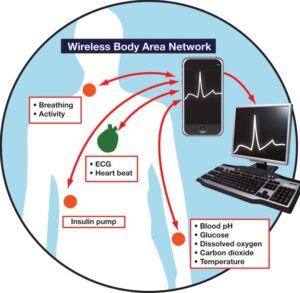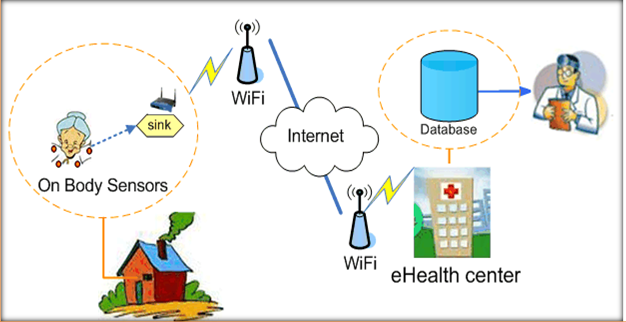Technologies are emerging day by day in order to improve the quality of life. Wireless Communication is a major factor that has made our life so much convenient than it was before. Healthcare and medical systems are also not untouched by this technological advancement. Wireless Body Area Network or WBAN is such a wireless network developed mainly to look after the personal health. It is also a good topic for thesis and research.
Is it WLAN or WBAN?
WLAN and WBAN are two separate concepts although their base is same i.e. wireless communication. WLAN stands for Wireless Local Area Network whereas WBAN stands for Wireless Body Area Network. There are a various thesis and research topics in WBAN. First of all, know the basic concept of WBAN.
Wireless Body Area Network(WBAN)
Wireless Body Area Network is a wireless network of devices which are wearable. These devices can be implanted inside or outside the human body. These are a type of body sensors mainly used for medical and healthcare systems. A WBAN can operate independently for the connection of various medical sensors and devices which are located inside or outside the human body. The idea of WBAN is developed keeping in mind the concept of WPAN(Wireless Personal Area Network) which is used for communication in a limited range around the human body.
WBAN is very helpful for professionals in medical line as well as for patients. The health of the patient can be monitored using this network at a distant location. Each node in a WBAN is an independent node which is able to search and find a suitable path for transmitting data at a remote location. The WBAN node can also connect to the internet for transmitting data. Using WPAN as a gateway, WBAN can be extended to a wider range and also the wearable devices on the human body can be connected to the internet. Information Technology is working in a big way to make the health care sector more efficient and advanced. With this technology, patients can be monitored at their homes thereby saving cost and time. This also helps in improving the quality of life of patients. Masters students can get to know more about this relatively new concept while working on their M.Tech WSN thesis.
A WBAN consists of two main things:
Sensor nodes
Gateway node
Sensor nodes collect data from the human body through sensors. A gateway node connects the sensor nodes to the external server and also to the other telecommunication networks. These networks can be a mobile network, WLAN, hospital network. The patient’s data can be transmitted through the mobile network using a 3G/4G network. This data can also be stored by the patient on his personal device. WBAN also find its application in sports training to monitor a sportsperson’s health.
Requirements of WBAN
For WBAN to work properly in healthcare systems, some specific requirements are there. These are:
- Reliability – High reliability is required when data concerning health is sent by the WBAN sensors.
- Latency – The response time to emergency situations should not be long. Real-time transmission is required in this case.
- Security – Personal and critical data should be handled with care to ensure the privacy and security of data.
- Power Consumption – Battery replacement in WBAN can be done easily. So there is no worry of power consumption.
Architecture and working of WBAN
WBAN is designed specifically for medical systems and for emergency situations. In such situations, the tiny sensor nodes in the network collect vital information from the body and send it to the medical server in the hospital. This information is then examined by a doctor or a physician in the hospital for diagnosis. The communication in the WBAN is secured because this network uses physiological values (PVs) which is personal human data. This will enable better healthcare facilities. Lack of security measures will lead to the wrong detection which is risky for human life.
WBAN uses cryptographic keys to secure communication. Specialized key distribution scheme is used which is of different type. Diffie – Hellman cryptosystem is used to prevent pre-deployment of keys.
WBAN differs from ordinary Wireless Sensor Networks(WSN) in the sense that the sensors in WBAN have limited power and memory. The security protocols of WBAN are different from that of WSNs. The key management protocols of WSN are also different from that of WBAN. WBAN uses plug-n-play scheme for security purposes. This security scheme is reliable with respect to network topology change. The main problem with this security scheme is the risk of information leak as during key agreement this scheme exchange more than required information.
For example, whole feature sets are exchanged between communicating sensors using this scheme. If the sender and the receiver have the feature sets same, then they will use a common key. This key can be easily generated by an outsider who acquires all these feature sets.
Multi-hop WBAN uses MICS(Medical Implant Communication Service) band for obtaining data from sensors that are located inside or outside the human body. For remote wireless communication WMTS(Wireless Medical Telemetry System) band is used. The data is transferred to the remote locations through local area network available in the medical centers.
For multi-patient monitoring, MAC layer is implemented on the hardware. A sensor node captures raw data from the human body. There are three main functions of sensor nodes:
Signal Detection
Digitizing and coding
Wireless transmission through a transceiver
The signal from the human body is amplified to increase the signal quality and strength. After that, the signal is converted into digital through analog-digital conversion(ADC). After digitization, the signal is stored in the microprocessor. The microprocessor transmits this data through a transceiver.
Students can get thesis guidance and thesis help in this topic from thesis guidance experts. Also, it is a very good choice for an M.Tech thesis in Wireless Body Area Network.
Applications of WBAN
The applications of Wireless Body Area Network(WBAN) are limited. A lot of development and research is going in this area to widen its applications range. WBAN find its application mostly in the medical and healthcare systems. Following are the main applications of WBAN:
-
Remote Patient Monitoring – Telemedicine and remote patient monitoring are the main applications of WBAN. Telemedicine means diagnosis and treatment of patients located at a remote location using information technology. WBAN has made it possible for delivery of certain healthcare services for patients at a distant location. Using telemedicine more and more patients can be served. Body sensors collect signals from the body and transfer it to the distant physicians and doctors for processing. Doctors can use this information for health estimation for medical diagnosis and prescription. This will create a smart health care system. Daily-life activities of patients can be monitored to collect vital parameters from the human body.
-
Rehabilitation – Through rehabilitative treatment methods, patients can restore their normal functional capabilities. Proper rehabilitation measures and therapy can enable a person, who has experienced a stroke, to function independently. These patients are constantly monitored to maintain a correct motion pattern. The main application of WBAN in this area includes sensor diversification, data fusion, real-time feedback and home-based rehabilitation health through devices that constantly monitors bodily activities. This will create awareness regarding certain physiological activities.
-
Biofeedback – Through WBAN, remote monitoring of human body can be done. The data collected by sensors can be accessed to gather valuable parameters from the body. Patients can look after and maintain their health through the mechanism of biofeedback like temperature analysis, blood pressure detection, ECG, etc. Biofeedback means maintaining and improving health through devices that constantly monitors bodily activities. This will create awareness regarding certain physiological activities.
-
Assisted Living – This helps in improving the quality of life. Assisted living technologies enable elderly and disabled people to be monitored at their individual homes. This will lower the healthcare costs. Through these devices and technologies, the condition of the health of the people can be estimated appropriately.
These are some of the major applications of WBAN. Besides this, WBAN is also used in sports training to monitor the health of the sportspersons.
WBAN Technologies
There are different types of technologies involved in WBAN at a different level. These technologies are a good choice for the thesis in electronics and communication. Following are some of the technologies in WBAN:
-
Bluetooth – Bluetooth is a short-range wireless communication technology in which upto eight devices can connect with each other. This network is also known as piconet in which one device acts as the master while other devices act as the slaves. It is a widely used technology for transferring data within a limited range. The devices in the piconet can exchange roles with each other according to the requirements. A master can become the slave or vice versa. A scatternet is a collection of two or more piconets. It is also used for communication between mobile devices and other Bluetooth-enabled devices.
-
ZigBee – ZigBee is a wireless technology used mainly in remote areas and consumes less power. The main feature of ZigBee technology is low cost and low power. ZigBee network can be simulated using NS2, OPNET, and NetSim. These simulators are open source and come with C and C++ library. ZigBee technology is built on IEEE standard 802.15.4 on the physical and MAC layers. The data is transferred in the form of data packets having a maximum size of 128 bytes. ZigBee devices are of three types:
-
ZigBee Coordinator
-
ZigBee Router
-
ZigBee End Device
-
-
IEEE 802 – IEEE 802 is a set of standards defined for Wireless Local Area Network(WLAN). IEEE 802.11 is a specification for Media Access Control(MAC) and a physical layer for wireless local area network. It provides a base for wireless network products and makes use of Wi-Fi brand. It provides high-speed wireless communication for transferring data at a large scale. High energy-consumption is also there in such communication network. IEEE 802.15.6 serves certain medical and non-medical applications and is also the first WBAN standard. The communications in and around the human body are supported by this standard. This standard makes use of different frequency bands for transferring data which includes Narrow Band(NB), Ultra WideBand(UWB) and Human Body Communication(HBC). This standard is specifically designed to support a wide range of data rates, minimum energy consumption, and a number of nodes.
-
Other technologies – Apart from these technologies, there are certain other technologies for WBAN application development. The Ultra-WideBand (UWB) technology is used for short-range communications providing high bandwidth. ANT protocol is another developing standard for healthcare and medical applications. The main feature of this is low speed and low power. It is supported by several sensor manufacturers. Zarlink technology is another technology for medical applications which require low frequency and low data rate.
Challenges of WBAN
Although WBAN is helping in a great way in medical and healthcare systems, still there are challenges which are to be tackled.
-
Security – Security is the main challenge for WBAN. Efforts are being made to make data transmissions in WBAN more secure and accurate. An individual patient’s data should not mix with other patient’s data. The data generated in the network should be secure so that there is no unauthorized access to the data. Confidentiality, integrity, and authentication are the main security requirements of WBAN.
-
Interoperability – The data transfer should be smooth across various technology standards like Bluetooth, ZigBee. The WBAN system should also be scalable such that the network connectivity is not interrupted when the network is widened.
-
Privacy – People are afraid that their private information may get leaked while using the WBAN network. Therefore WBAN must ensure the privacy and security of the individual information.
-
System Devices – The devices used in the network must have low complexity, lightweight, low power consumption, and energy efficient.
-
Sensor Validation – The data collected by the sensors need to be validated. This will help in identifying issues in the hardware and software designs. False readings can cause wrong data being sent to the end user.
-
Data Consistency – The consistency of data should be maintained. In the wireless body area network, the data is fragmented and transferred at various nodes. This can cause inconsistency of data. Therefore consistency of data should be maintained.
-
Interference – For the large-scale implementation of WBAN system, interference should be less. This will increase the coexistence between the sensor nodes with other devices in the network.
-
Data Mangement – A large volume of data is generated in WBAN. Storing and managing this amount of data is a challenging task and also important.
This was all about Wireless Body Area Network(WBAN). The main thesis topics in WBAN include architecture, applications, and technologies. For any help related to thesis guide and research on WBAN, contact Techsparks.






Leave a Reply